August 2018
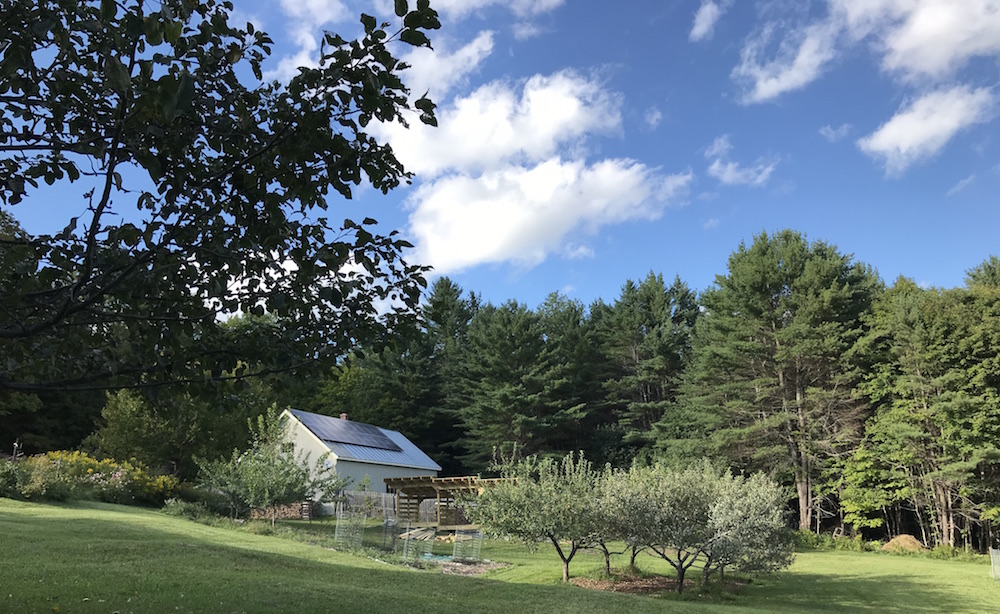
August is a languid, rolling experience of heat and bounty so prolific it’s overwhelming. We wait all year for baking sun and endless veggies and then when it happens, it’s almost too much to bear.
There’s a temptation to run and hide from the mountains of chard and the opulence of tomatoes. But we pause, we remember that soon enough, it’ll all be gone, evaporated and enveloped by snow. And so we go again into the garden and into the woods to savor and work these fleeting summer hours.
If you’re just tuning in, this is a recurring series in which I document each month of our lives out here on our 66-acre Vermont homestead. After leaving urban Cambridge, MA in May 2016 to chart this wholly different life, we’re experiencing a constant learning curve of exploration (and plenty of stupid novice moments). Check out last month’s installment here and enjoy the best and worst (ok, mostly the worst) moments of our first year on the homestead here. Wondering if it’s less expensive to live rurally? Check out: City vs. Country: Which Is Cheaper? The Ultimate Cost Of Living Showdown.
Woodshed Building Extravaganza!
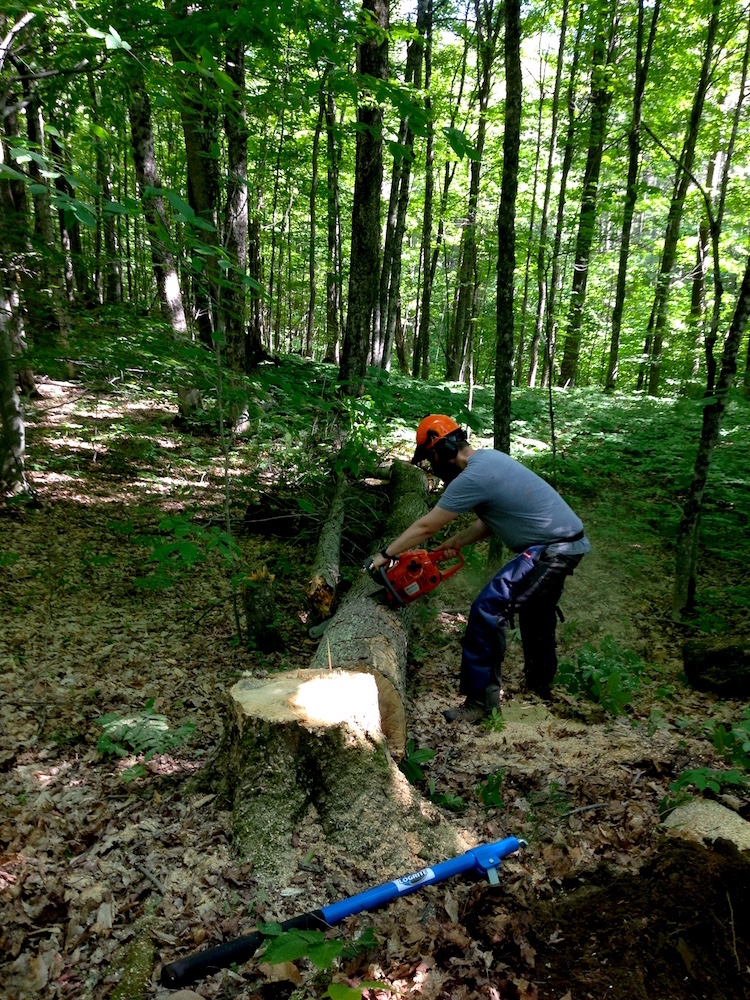
While some other things happened on the homestead in August, it was all dwarfed–quite literally–by Mr. Frugalwoods’ construction of a woodshed.
In the interest of transparency, I’ll concede that he didn’t actually finish the thing until September, but for the purposes of a lovely, flowing narrative (which is what really matters in woodshed construction… ), I’ll cover the entire operation in this August rundown.
We begin with an existential pondering: what is a woodshed? Why does one need such a thing? Where will it come from and where will it go?
Heating A Home With Wood From Our Land
We heat our home with a woodstove, which–as you’ve probably surmised by now–requires wood. We live on 66 acres of heavily forested land and so we have an over abundance of raw burning material at our disposal. Harvesting trees is an important element of maintaining a healthy forest and it’s necessary to clear out dead/dying/problematic trees anyway, so burning them to heat a home is doubly efficient.
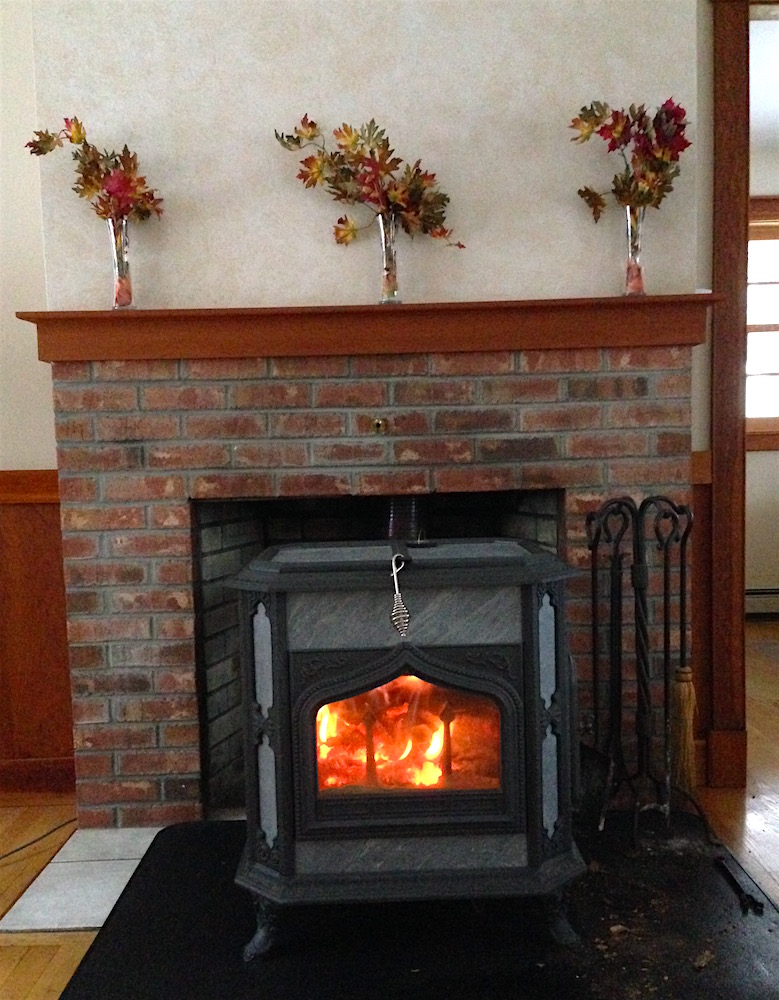
Fortunately, we have a modern, highly efficient woodstove, which I discuss in detail here. Mr. Frugalwoods fells trees himself (using a chainsaw and all required chainsaw safety gear) and then skids the trees using our logging winch and tractor (read about that here) and then bucks and splits the wood for us to burn (more on that here). I’ve done quite a bit of writing about this exciting tree extraction process in the past, so check out past posts for all the details. And don’t operate a chainsaw without safety gear and training (both of which Mr. FW has)!
Given our reliance on wood to heat our home during icy Vermont winters, we need a place to store said wood prior to burning it. Strangely enough, our property lacked a woodshed. A previous owner built a lean-to woodshed on the far side of our barn, but it’s woefully inadequate for wood storage because: 1) it’s too small; 2) it doesn’t get direct sunlight; 3) it has no airflow from either side; 4) it isn’t close to the house. Other than that, it’s perfect! We initially considered keeping wood in our basement, but were advised by several neighbors that this is a great way to introduce bugs into our home (bugs live in wood and when the wood comes inside and warms up, out pop the buggies!). No thanks. Plus, our basement is fully utilized for storage. Additionally, keeping wood inside doesn’t allow it to fully dry and cure (more on that thrilling process later!). So that plan was flawed from the start.
How We’ve Been Storing Wood (spoiler: not well)

We landed on the non-ideal solution of storing our split firewood in rows atop pallets in our yard, covered with metal roofing panels. This works out okay, but isn’t optimal as we had piles of wood scattered around the yard, the metal roofing blows off (often), snow drifts up around the piles, the pallets start to rot due to ground moisture, and the piles fall down periodically (which, while funny to watch, is a royal pain to re-stack).
This system is also derelict at keeping rain off the piles. We didn’t want to rush into building a gargantuan woodshed if we could skate by with random piles of wood in the yard, but the aggravation and insufficiency of the piles prompted Mr. FW to take serious action. Most crucially, this system didn’t allow the wood to dry properly, which grievously impacts its ability to burn well.
Why Wood Needs To Dry Out (newsflash: you can’t use a towel)
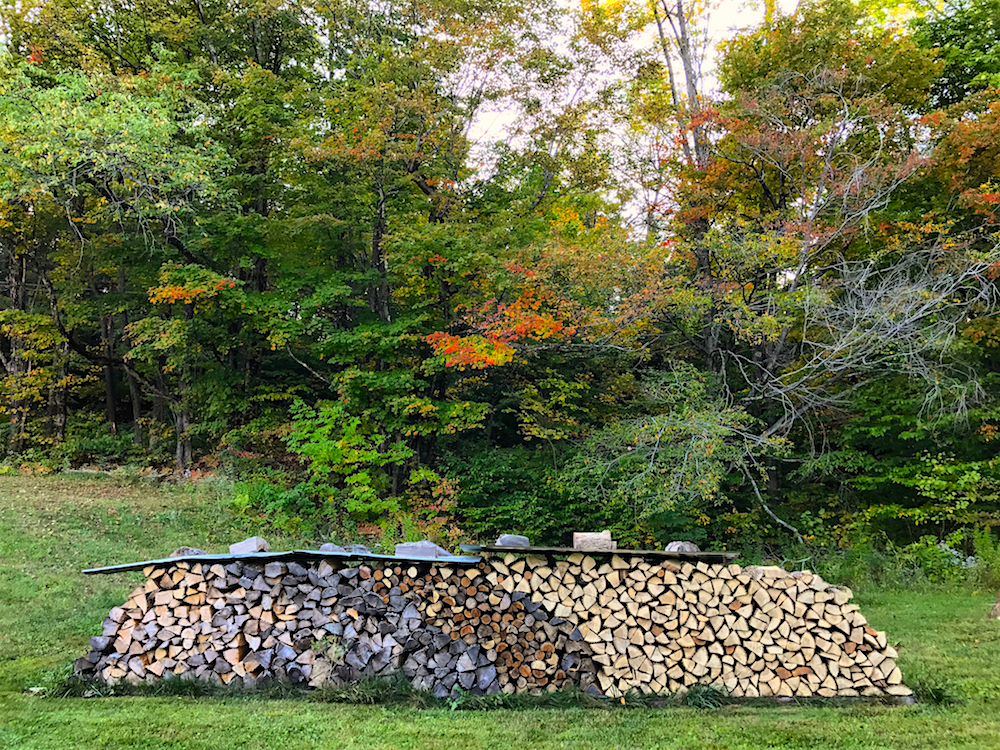
Wood burns most efficiently when it has under 20% moisture content (oh the things I learned while writing this post! Can’t believe I could make it through a day before knowing this). Depending on the species of the wood, when you fell a tree, it’s going to have between 40% and 60% moisture content, which means if you were to burn it soon after cutting it down, the energy in the wood would be used largely to boil off the water instead of producing heat (which is your goal). Wet wood is also harder to start, harder to keep burning, and overall less efficient.
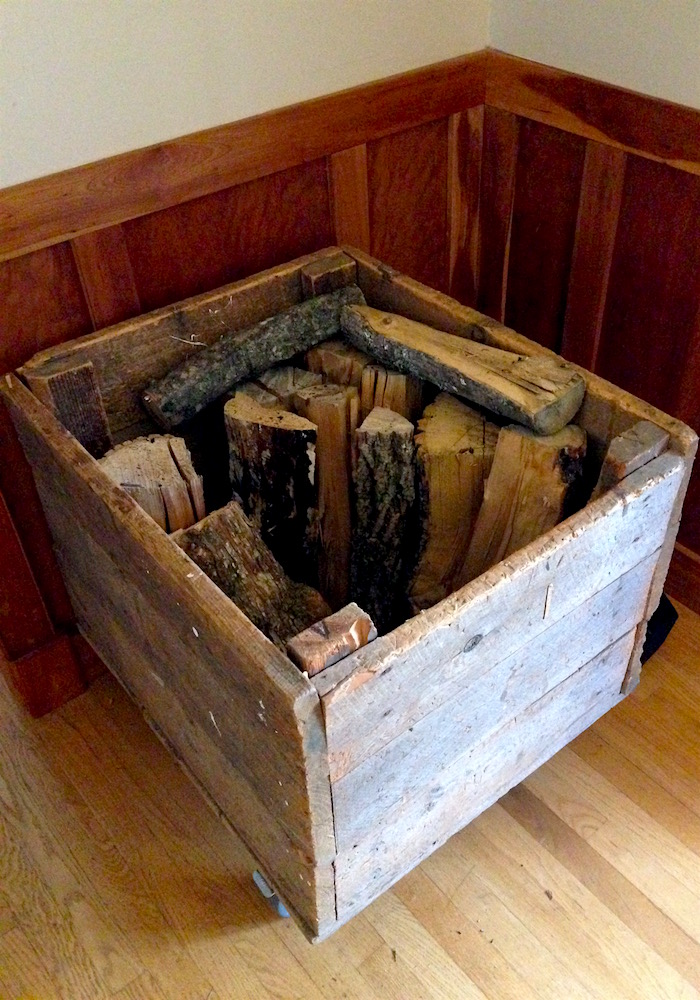
Given this, it’s important for wood to have time to dry out prior to being burned to heat a home. Any amount of time for wood to dry is better than no time, but longer is better. Many folks aim for at least one year of drying, which means they’d cut wood in the fall of 2018 to burn during the winter of 2019-2020. However, for some of the denser woods such as sugar maple and hop hornbeam (which we happen to have a lot of in our woods), a year is not quite enough to get it below 20% moisture content. And by “year,” I really mean summers because in our climate, wood is only truly drying from May to October. Thus, we’ve arrived at the conclusion that two years of drying should be ideal to get these denser woods up to their highest BTU potential.
The reason to burn denser woods is that they’re more efficient and burn hotter and longer. There’s more heat energy (BTUs) in a piece of hardwood (such as a maple) than in a piece of soft wood (such as a white pine). Here is a very handy chart outlining the BTU content of a lot of different types of wood. If you’d like to nerd out over BTUs and wood cord size, check this action out. I’ll be honest, I did not read that, but Mr. FW did and proceeded to give me a lengthy explanation… You’re welcome.
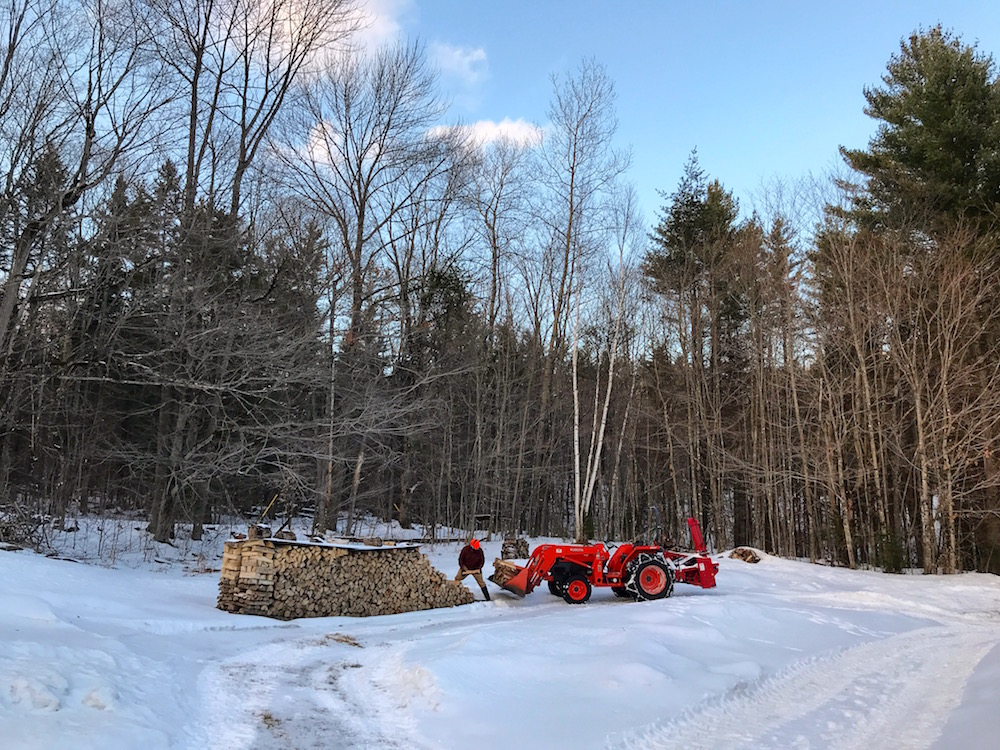
At any rate… how on earth do we know how much moisture content a given piece of firewood has? We lick it. Just kidding, we have this moisture meter that measures moisture content (that’s an affiliate link). However, once you’ve been doing it for awhile, you can tell by the way wood feels and sounds when you hit it against another piece of wood (that’s the technical explanation). For us, using the moisture meter was helpful in learning this calculation.
The sum of all this wood drying excitement: A properly sited and designed woodshed is instrumental in facilitating the proper drying and storing of wood.
Determining Woodshed Size (go big or go home)
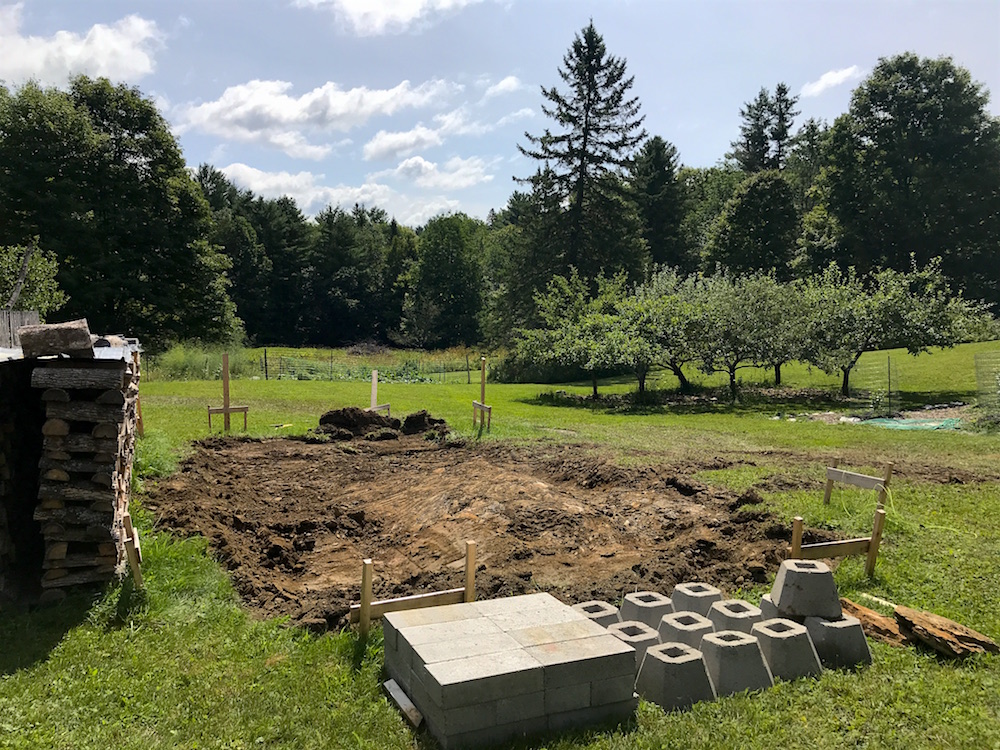
The first data point was how big the thing should be, which entailed estimating how much wood we use per heating season. After two full winters of burning wood, Mr. FW deduced that we use about three cords of wood per year (more on what a cord of wood is here). Given this, Mr. FW decided he wanted a shed that would, in total, hold three years worth of wood, which is nine cords total.
He landed on a design of three bays whereby each bay holds one year’s worth of wood (which is three cords). Was that confusing? I re-wrote it six times in an effort to clarify, so hopefully it makes sense. Let me try again: The shed holds a total of nine cords of wood, which will last us three years. Each bay of the shed holds one year’s worth of wood, which is three cords. Just look at the photos of the shed.
Where Should A Woodshed Go?
Next, we had to decide where to put the woodshed. Since it’s a massive structure, we wanted a location that wouldn’t obstruct our view of the woods from the house. But, since this wood will eventually be burned inside the house, we wanted it close to the house. We also needed a spot that faces south(ish) to capitalize on sunshine, since sun is a great dryer-outer of wood (and other things). Additionally, we didn’t want to plop the shed over any ground that might one day be a garden bed or chicken coop or garage or other such device.
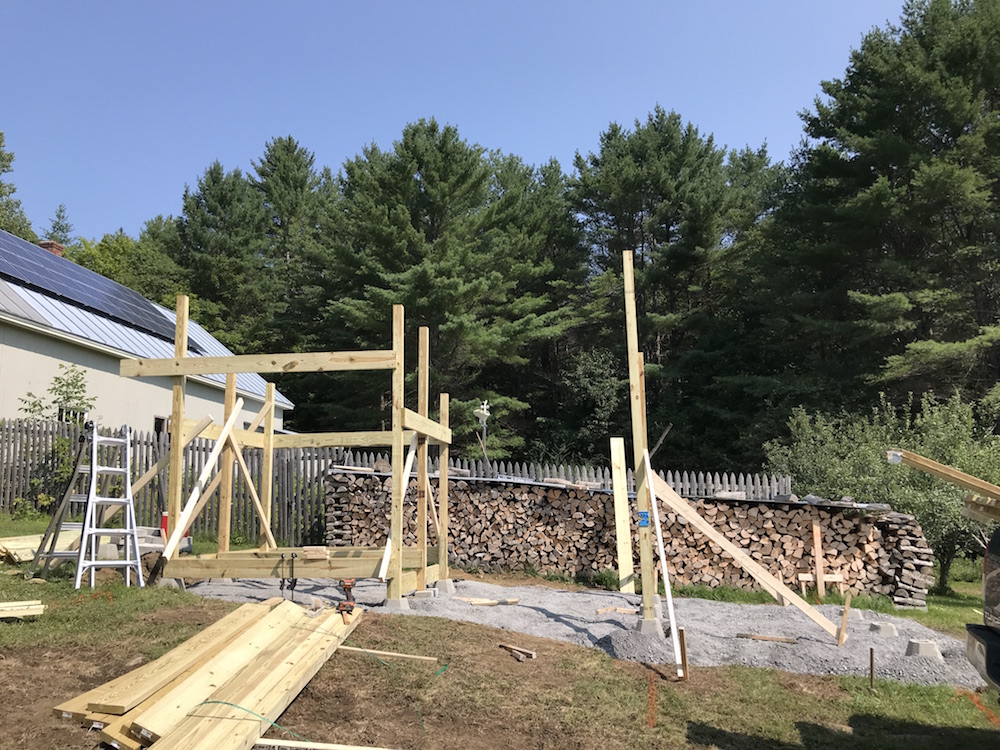
We initially considered placing it next to our barn, but realized that it wouldn’t get enough direct sunlight over there. We then moved onto a spot just outside our second garden gate, adjacent to the barn since it meets all of our site requirements and faces sunny southwest. The only downside of this location is that it’s on a slope, which entailed some crafty engineering on the part of our woodshed designer and builder (that’d be Mr. Frugalwoods).
Before breaking ground, we obtained a permit from the town, an important element of any construction project! Always permit first and build second! Mr. FW staked out the footprint of the building with wooden stakes and rope so that we could envision how it would look on the landscape. We walked around and considered it from all angles and decided it was perfect (or at least, good enough!).
Designing A Woodshed
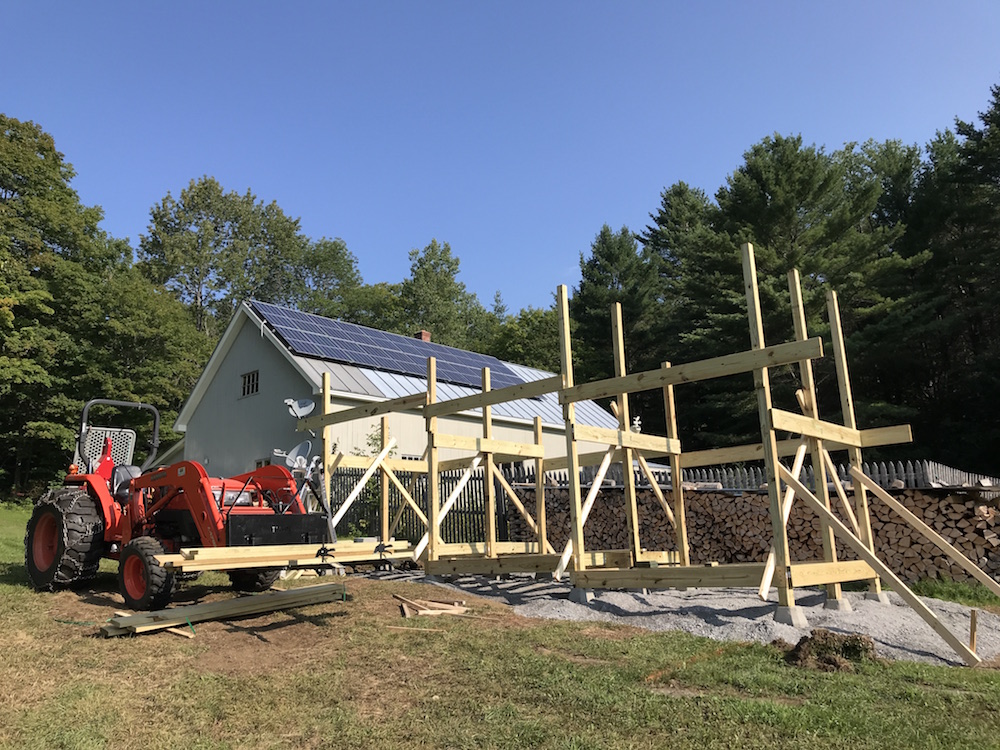
Since Mr. FW had a specific size and layout in mind, and since he was contending with both rock ledge and a slope, he wasn’t able to use a pre-existing woodshed layout or design. He had to make it himself. After conducting extensive internet research (I feel like everything we do is preceded by those five words… ), he used Sketch Up (a free 3D design program) to model out the entire building.
He came up with a design that’s graded in order to accommodate the sloping land, which essentially means each bay is its own discrete module. Mr. FW also calculated roof overhangs, how the structure should rest, and of course, structural soundness (hey! It won’t fall down! We hope!).
Preparing the Site
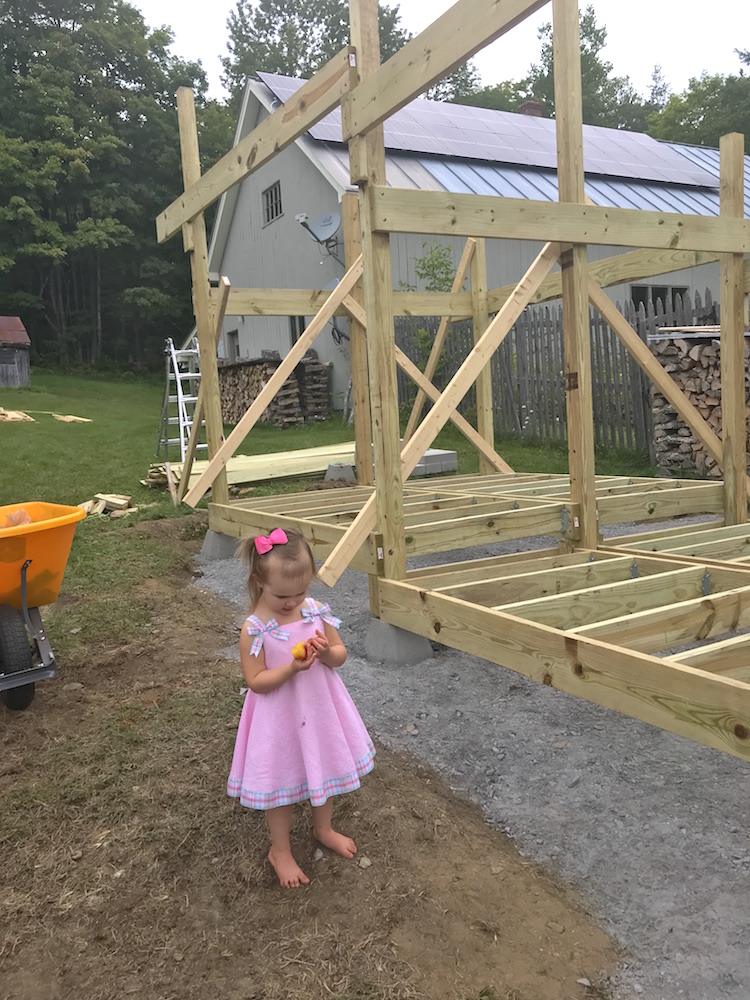
To prepare the site for the build, Mr. FW first scraped the grass and topsoil off with the tractor. Next, he spread crushed stone to serve as a foundation to help roughly level the spot (although it’s still sloped). The idea is that this stone will provide a firm foundation for the structure because crushed stone packs down tightly.
Typically, you’d next dig down below the frost line; however, our frost line is more than five feet deep and there’s rock ledge below the surface… so, he used floating deck blocks as the foundation pillars. He then built what he terms “a typical pole building.” Can you tell why I’m the one to write this stuff up?
Materials
This woodshed is built of, uh, wood. Since we don’t (yet) own a saw mill, we’re not able to make our own lumber, so we had a load of lumber delivered. When buying this much lumber, it makes sense to have it delivered because, for us, it was the same price as it would’ve been had we picked it up, since our lumber yard delivers for free over a certain amount ordered. They were also able to set the lumber exactly where we wanted it with their boom truck, which Babywoods watched with extreme interest. This much lumber would’ve entailed at least five trips in our pick-up truck, so it much more efficient to have it delivered.
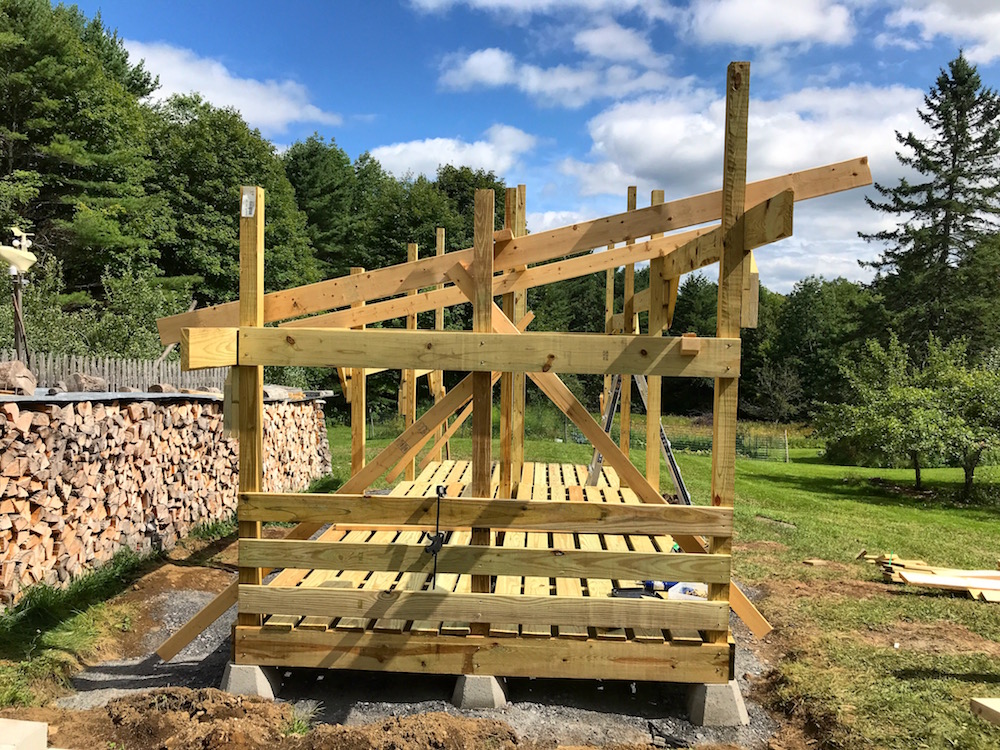
An important note here that anything within two feet of the ground is ground-contact pressure treated lumber (important for staving off rot!). The roof is galvanized metal roofing slats that are each 3 feet wide x 12 feet long. There are also a bunch of screws and nails, which are used to hold things together. I added that last sentence myself by drawing on my extensive construction expertise.
Final Stats
The full footprint of the woodshed is 8 feet x 24 feet and the roof is 12 feet x 28 feet, since there’s significant overhang to keep rain and snow off the wood. The height inside each bay ranges from 4.5 feet in the back to 7 feet in the front. I think this thing qualifies as more of a wood palace. The floor boards and the side slats are spaced wide to allow airflow, which is conducive to wood drying.
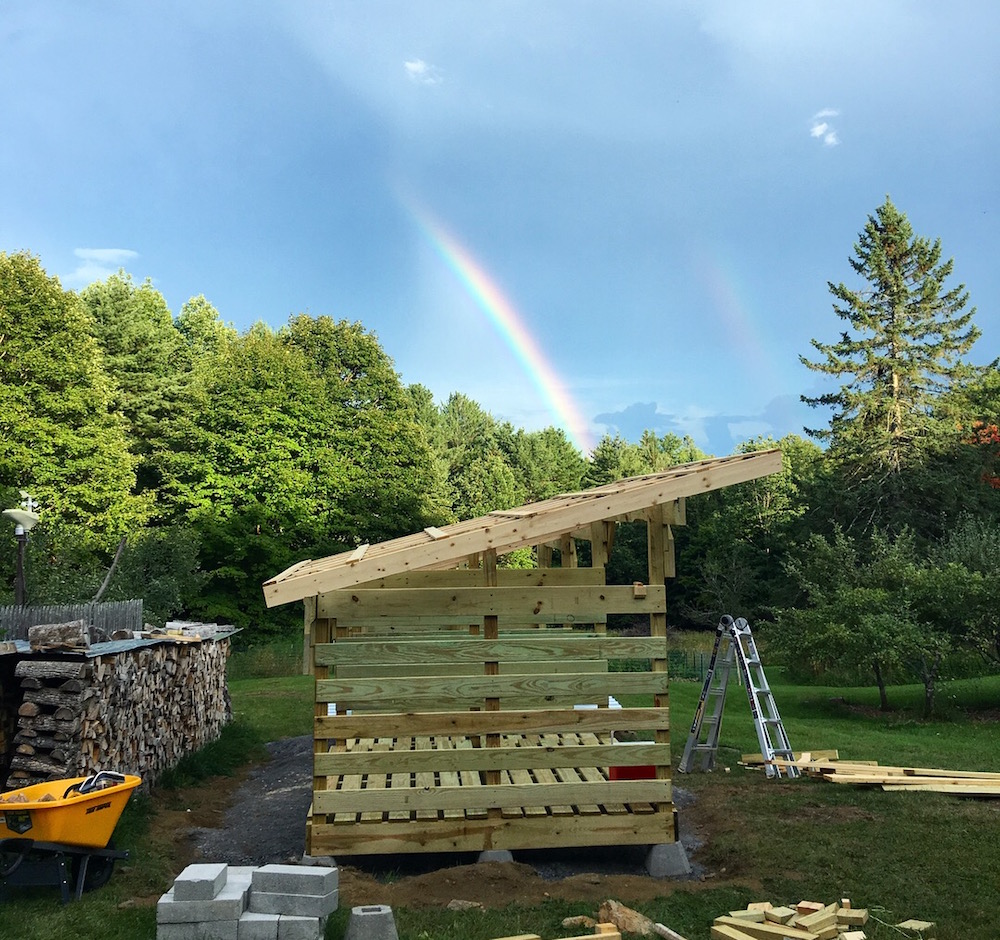
It took a lot of early mornings, late nights, and long weekend days, but Mr. FW built this thing all by his lonesome in about two and a half weeks. This does not, however, include the months he spent planning, designing, and researching. All told, it took a ton of time, but the result is a beautiful woodshed–for only the cost of the materials–that’ll serve our homestead for decades to come. Plus, as he said every single time he came inside after working on it–this is the type of manual labor that he loves doing.
Creating a vision on paper and then building it with his own hands is a deeply fulfilling, satisfying aspect of our lives out here. My husband loves to build things and loves to learn new skills and this woodshed certainly provided him with those opportunities. He debated roping friends in to help at various stages of the build–in particular with putting the roofing on–but he wanted to see if he could do it on his own. And he could. He reports that, with the proper amount of planning ahead, building of jigs, and using of clamps–it is possible to build something this large on your own.
For our local friends, he’s now interested in organizing a “woodsheds and whisky” tour whereby you go around town to look at each other’s woodsheds and drink whisky. Please call/email him to arrange (my work with this is now done).
Blackberries!!
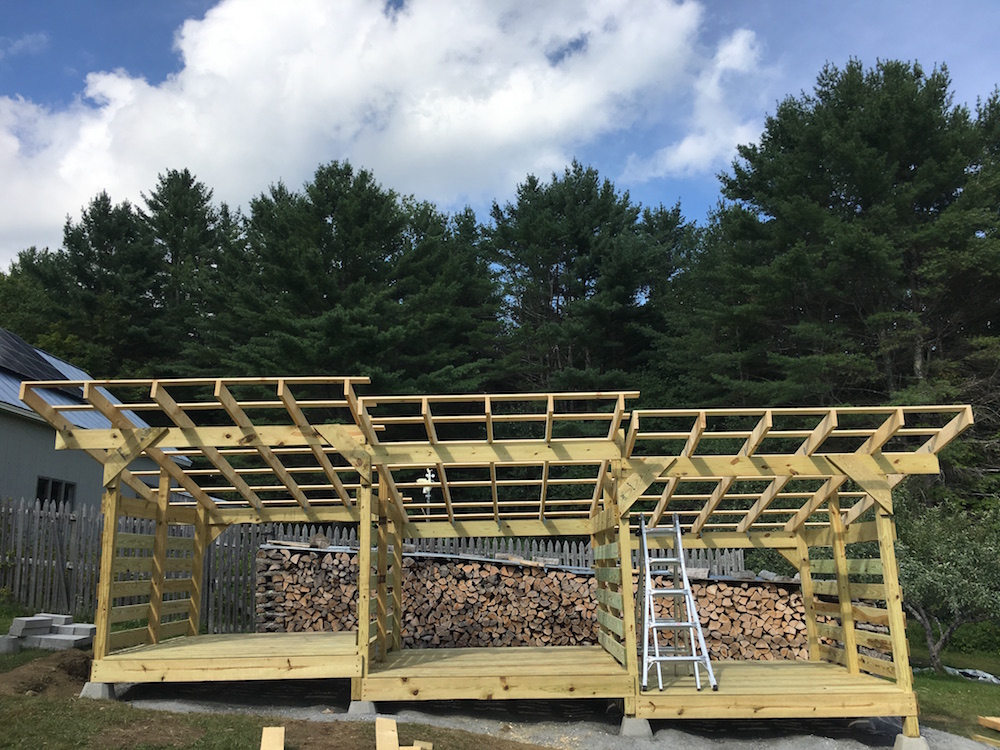
See, I told you something other than a woodshed happened last month. Blackberries came ripe! We are the proud owners of a rollicking mess of wild blackberry bushes. Seriously, it’s a gigantic jumble of thorny vines in the woods that skirt our yard, but it is loaded, packed, and laden with delicious blackberries.
And so, like a mama bear and her cub, Babywoods and I set out every other day into this thicket armed with our empty yogurt container pails to pick and pick and pick. Or eat and eat and eat in the case of Babywoods, who managed to save exactly zero blackberries. That child is at least 60% berry at this point.
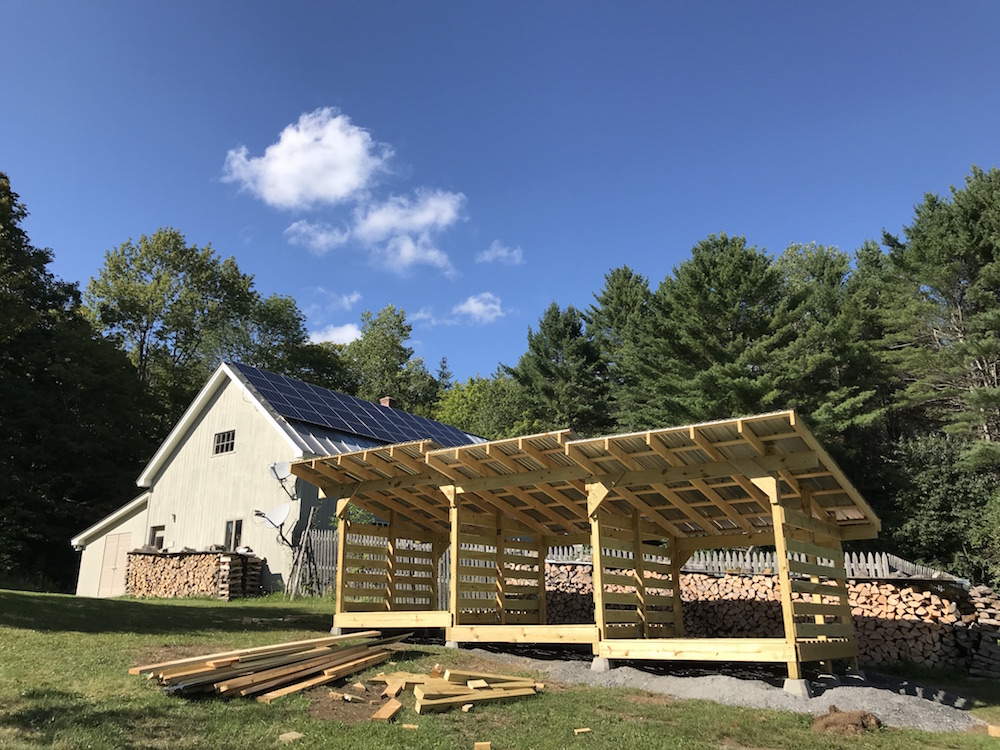
We trampled down pathways to navigate the thronging plants and learned where the biggest and juiciest berries grow. Thanks to the book Blueberries for Sal (props to my mom for getting that from a yard sale for us), Babywoods was ALL IN on the berry picking this year and spent a fair amount of time bushwhacking through vines with me in search of tasty treats (that’s an affiliate link).
I managed to not eat everything I picked and froze about four gallons of berries for the winter. I don’t bother making jam or jelly since we make apple butter from our apples. As I’ve shared before, I utilize the lazy method of dumping berries into a ziplock bag and tossing them into the freezer, a methodology that works just fine. I then defrost as needed and pop them into salads, much to the delight of anyone who eats salads at our house.
Dehydrated Cherry Tomatoes Are Delicious: Who Knew?

Everyone but me, apparently. THANK YOU to the following amazing Frugalwoods readers who suggested that I dehydrate our excess cherry tomatoes: Penny, Jess, Krysten, Natasha, Soggysuzzi, Beth, Kate… yep, basically everyone who read the post ;).
Really, guys, my farm incompetence knows no limits and I had no clue you could dehydrate these babies. But now I’m a devoted convert!!! I slice the cherry tomatoes in half, pop them into the dehydrator, and a quick 24 hours later, they’re dried! I’ve elected not to dehydrate my tomatoes all the way because I like them slightly mushy (plus I get impatient of running the dehydrator after 24 hours and want to take them out!).
Due to this, my tomatoes aren’t shelf stable, so I’m freezing them. But, if you were to dehydrate them all the way, they would be shelf stable. I am looking forward to feasting on these little sunshine rockets all winter long (well, actually, given how much Babywoods loves munching them, they’ll probably only last us a few months… going to plant more cherry tomatoes next year).
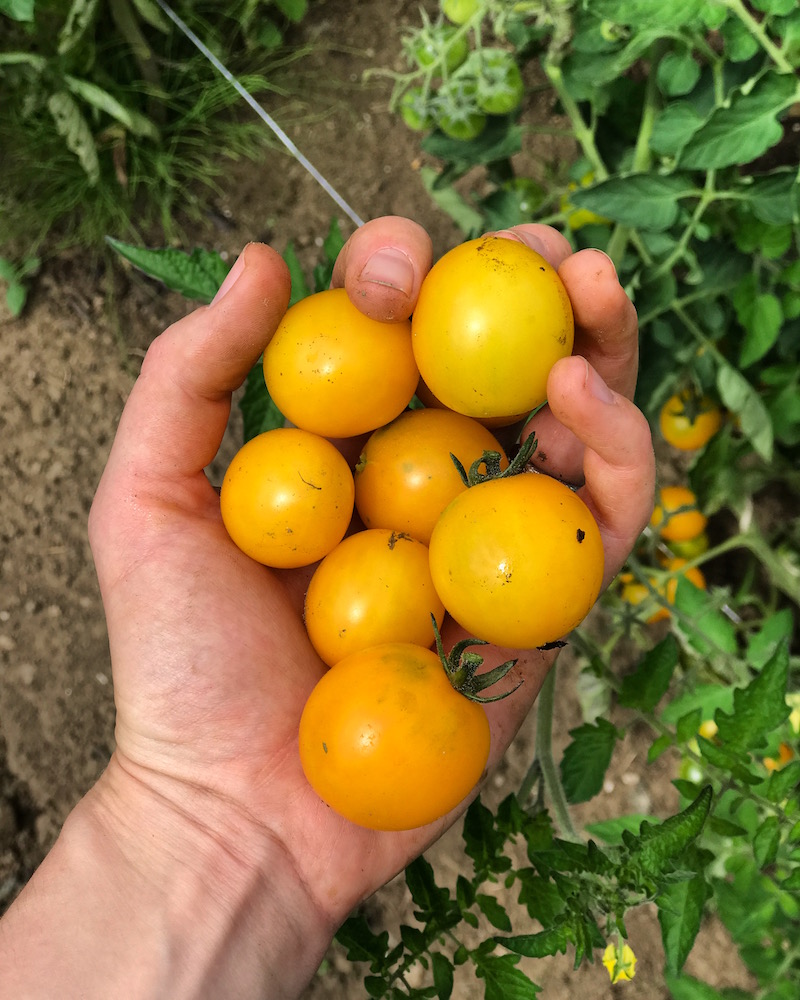
I like this system because it’s easy and requires very little labor by me, unlike canning, which requires quite a bit more timing and concentration (both of which are in short supply in our household of an infant and a toddler). Babywoods got into helping me put tomato halves on the dehydrator, by which I mean she got into eating all of the tomato halves she was supposed to be placing in the dehydrator…
Inquiring minds who want to know: I have this dehydrator, which we bought a few years ago in order to dehydrate our apples (that’s an affiliate link). But I gotta tell you, I love dehydrated tomatoes even more!!! This is not, to be clear, the world’s greatest dehydrator, but it works and it’s cheap.
Along those lines, many of you clarified that you CAN can salsa and I was confused for a few days until I realized that we were talking about different types of salsa. Mr. FW makes a fresh pico de gallo type of salsa that isn’t cooked and we’re not fans of the traditional jarred, cooked tomato salsas. So I think for now I’ll stick to dehydrating cherry tomatoes as a means of preservation and we’ll just enjoy fresh salsa when the garden sees fit to grow the ingredients. Thank you, readers! Keep those good/how-dumb-are-you-Mrs-FW suggestions coming!
Where Are The Wildlife Camera Pics???
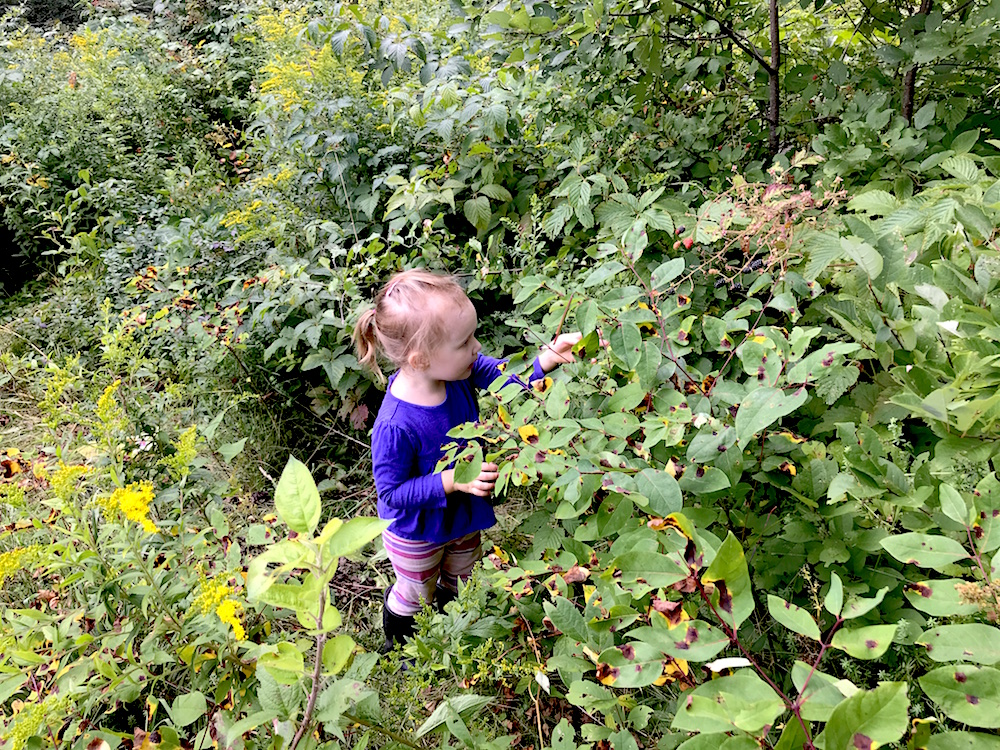
This question was posed to me by my own mother and quite a few readers, which informed me that my grainy, black-and-white photos of wild creatures skittering away are, in fact, quite popular. Thank you for that.
These queries also prompted me to go get the chip from our wildlife camera so as to share said photos with you (that’s an affiliate link). What I discovered is that the camera was not turned on. So, uh, yeah. No photos this month, but I DID turn it on, so hopefully I can regale you with some deer legs or bear butts next month. See note re. my incompetence above.
Want More Fotos?!
While I only document homestead life once a month here on the blog, I post photos to Instagram (almost every day!) and updates to Facebook with much greater regularity! Join me there if you want more of our frugal woods.
And if you want to make sure you don’t miss a post here, sign-up for our handy dandy email list in the box below. You’ll get a message from me if you do…
Onward to September, frugal comrades!


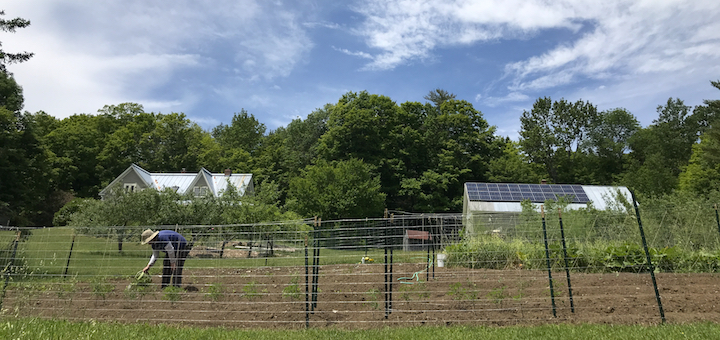
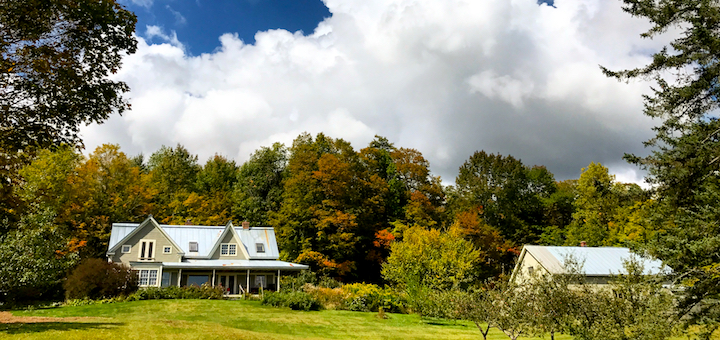
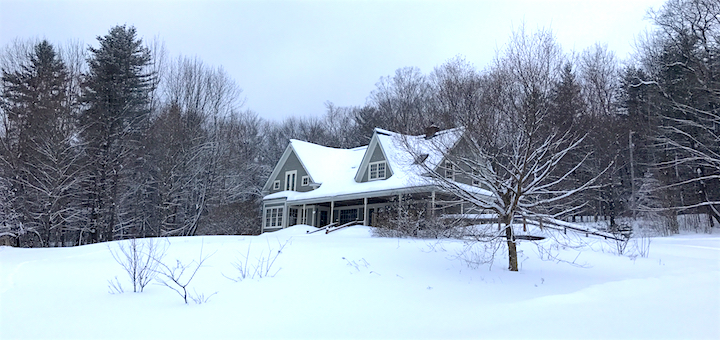
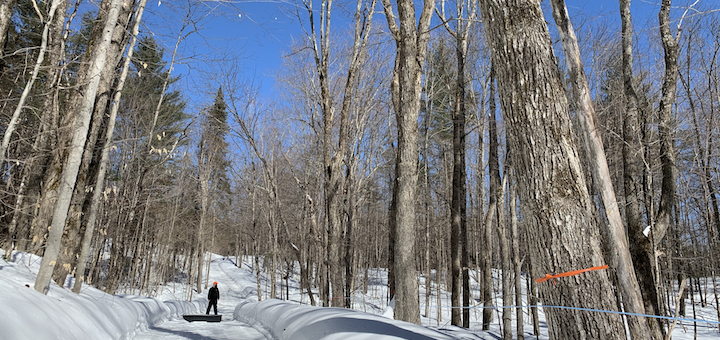

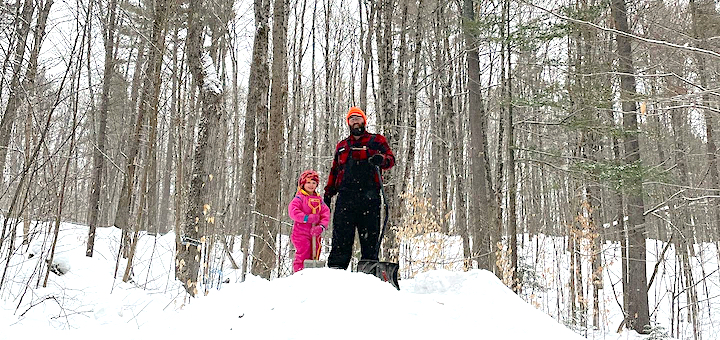
I love your Instagram photos! I would love to see regular updates on what your family eats – how has your grocery shopping changed now that you grow some of your own produce?
Thank you! That’s a good question! I’ve gotten a lot of questions on our meals lately, so I’ll try and pull something useful together 🙂
Here in Oregon’s Willamette Valley, blackberries are a weed. But they’re a delicious weed! We had some visitors from Texas last month, and they were shocked that blackberries run rampant here. That’s okay. I’m always shocked when I see citrus trees. Those won’t grow in the Pacific Northwest. For me, it’s fun to see what what “wild” fruits and berries different locations take for granted. (p.s. I never knew blackberries grew in Vermont, but I guess it make sense.)
The woodshed looks impressive! I was wondering about the rain in your previous posts as well. It takes the rain 2 mins to soak the wood with water and might take weeks for the wood to dry.
I have never had dry cherry tomatoes before. Glad they taste good!
Way to go Mr. Frugalwoods! Please let me help when you build the garage! At the very least I can help wrangle kiddos 🙂
Please no more with the incompetence jokes! You are smart and competent and creative and have a million things going on and unless you grew up on a farm, there’s a lot you wouldn’t have occasion to learn.
I couldn’t agree more! Well said, Jennifer.
Agreed! You guys are amazing and have learned so much. Embrace it and take credit for all you have accomplished!
It is normal to be self deprecating but since you shared so much vulnerability recently, and since I have depression too, and since I remember that clip from Pretty Woman where she tells him that the bad stuff is easier to believe…
I want you to take a moment to let it sink in that you write sooo well and engagingly, I’d love to come and visit (if that wasn’t freaky stalker-y), and you’re doing great. You got this!
Also, showing my pitifully small amount of wood knowledge (although I can build a fire from scratch), doesn’t the wood get wet? And doesn’t that stop it burning?
Just chiming in to agree with what Jennifer, Carolyn and Victoria have said. You should be incredibly proud of what you are achieving – both on the homesteading and parenting front. Neither are easy and both you have to learn as you go! 🙂
Yes. Coming out of lurking to chime in. Think about this: how many years have you been doing this and how many things have you learned and tackled during that time…while having how many kids? Hmmm. Sounds like a superwoman cape is in order here.
As someone who is in the homesteading research / planning phase, I have learned so much from you. As a mom of just one grown kid, I am awed by what you have accomplished.
Hugs and gratitude…
She’s right! It’s so easy for us mamas to feel incompetent when our babies are little and there seems to be no end to nursing but you’re not incompetent! Absolutely not! You’re job is irreplaceable and worth gold! You’re doing a great job!
I so appreciate it, but YOU GUYS, self-deprecation is my sense of humor!!! You’ve got to let me have it–it’s how I laugh my way through life. Trust me, if the self-deprecation stops, then we’re in trouble ;). Mr. FW and I joke all the time about our “homestead incompetence” because we are truly learning as we go and we LOVE this continual process of try and fail (and then try again). It’s our favorite way to live. Plus, by admitting how much we don’t know, we’re able to learn and grow everyday.
That’s a good looking woodshed. BTW – your boxwood looks exactly like the one we had when I was growing up – makes me a little nostalgic. Nothing better than sitting next to a warm wood stove on a cold winter day with a good book!
I am loving this post! The abundance of August is truly amazing, and your work is inspiring. Thank you!
Greetings from Finland!
You seem to have nearly the same kind of climate in Vermont as we have in Finland. Thus many things you write about are familiar to us Finns.
I wanted to tell you of an old method of drying wood faster that was used in Finland in the old times. You could fell a birch tree (or maybe some other leaf tree) in the summer and leave it laying on the ground until it dried and leafs became yellow and fell off. The leafs evaporate water from the tree effectively. Then you can chop the tree in the autumn and use it as fire wood already next winter.
But since you have a large stock of wood this fast method is maybe not so needed. I let most of the fire wood dry two years before burning. Birches are my favourite.
Thank you for taking the time from your very busy life to share you stories. I enjoy your humor, it makes me smile. I also enjoy the level of detail that goes into your posts. Not that I need a woodshed, but If I did I know where I would go.
Thank you! And hey! You never know when you might need a woodshed 😉
Does North Pomfret count as local? Would love to take a closer look at how this was constructed (especially the floating deck). I don’t have a shed to offer in return (yet), but I do have whisky 🙂
Ahh I love that woodshed! It’s not only functional, but also beautiful! Hopefully that will help with the wood drying. 🙂 I admit I snorted on my coffee imagining y’all licking the wood.
August was a good one for our suburban homestead. Our okra was super productive. Unfortunately, I hate okra and hubs’ attempts at pickling it were unsuccessful. We ended up putting it all in the compost bin! Ugh.
I guess I’m ahead of myself, but I have to brag about September. Y’all. We are FINALLY paying off our student loans this month. Which means I can quit my job next month and pursue writing full time. I’m so happy I could scream! After that, we’re demolishing our car loan in two months. We’re going to start 2019 debt free minus our mortgage. I never thought this would happen, and I’m just so happy. <3
Congratulations!!!!!!!!!!!
Congratulations! Well done, Mrs. Picky Pincher.
Wow! That is wonderful news! Huge congratulations :)!!!
Cherry tomatoes are delicious when dehydrated. However…they are to seedy to make a sauce with. I tried this one year when I was drowning in them. The seeds make your sauce bitter. Just fyi. I happened to bookmark your handy dandy BTU chart for wood. We have holly and dogwood that was given to us. It’s so heavy when green. These woods prompted our purchase of a splitter, because you cannot chop the stuff. It’s incredibly dense, but as I just found out in the top ten for BTU output. Color me thrilled!
Woohoo on the BTUs! Yeah, that was one the reasons we bought a splitter as well–those dense woods can be nearly impossible to split by hand and we realized we were gravitating toward lower BTU woods because they were easier to split (not a good longterm strategy 😉 ).
Ah, August is such a great month and you’ve captured it perfectly. FYI, you are very competent- my tomato harvest included exactly 2 tomatoes (although I’m kind of pumped that I grew them from seed). We scrump wild blackberries, they were abundant and delicious. Last year we even made berry wine, this year they died out before we had the idea. Wine is easy to make if you’re looking for another project, although you’re probably swimming in cider 🙂
Lots of great laughs in this post. “We lick it. Just kidding!” This seriously had me glad I wasn’t drinking coffee at the time!
We volunteer to move wood from random piles to the Wood Palace! I’m good at picking things up and putting them down.
Be careful what you offer… we might take you up on it! Can we rig the dogs up to a wood-pulling sled ;)?!
I’ve noticed that nearly all of adult life involves simply picking things up and then putting them down.
Reading this post brought back memories of my childhood! My parents heat with wood on 4 acres in Connecticut, and cutting and chopping and moving and drying firewood was a continual process. We would lay it out on the driveway to bake in the sun and often have to rush to stack it when we caught sight of a pop-up thunderstorm in the summer.
Do you run the stove all night, or do you switch to conventional heat for the overnight hours? I think my mom’s biggest complaint is having to rise every couple hours to put another log on the stove.
We are really fortunate that our stove is high efficiency, so we make a fire right before going to bed and it’s still smoldering by morning. Mr. FW started out with feeding the stove during the night (he’d just get up with me when I nursed Babywoods), but we soon realized it wasn’t necessary. We do have back-up baseboard heat so if the temps really dip during the night, that’ll kick on. But usually, we just coast until morning.
My grandparents used to pick berries on their farm and make all their kids’ families sauce. My dad would say the sauce was worth more than printer ink given how much work goes into picking berries.
I’m sending my husband that woodshed pic ASAP – we’ve been talking about building one for 2 years and are still dithering about location and plans!
And FYI., for fully dehydrated tomatoes : freeze them and toss them in the food processor to make a tomato powder, and then you can use that instead of tomato paste in most recipes. Very convenient, keeps much better, less of a pain to handle, kicks up soups a notch all winter.
Wow! Such an impressive woodshed!
Our garden has produced so many tomatoes this year! I just freeze them all whole and use them in chili and marinara sauce throughout the winter since the fall is so busy with processing other foods.
one suggestion for the dehydrated tomatoes is to throw them into cooking pasta for like the last 5 minutes. then drain and add basil/evoo/lemon. it’s the BEST quick dinner ever!
His hard work paid off, the shed turned out great! We are going to try dehydrating tomatoes for sure, thanks for the tip!
That wood shed looks great!
My 18-month old is about 80% blueberry this summer, but sadly, ours comes from Costco. The only thing we grow ourselves is apples, and the bugs let us save about 10 per year.
Thanks for the moisture meter link. I unfortunately need to get one because I just discovered carpenter ants in my log cabin where I live. Grrrrrr.
Also I need to figure out firewood. I have a woodstove in the house I’ve just moved into (which I need to get checked for safety, and unfortunately there’s nobody local to do it so I may have to fly somebody in, sigh). I do not have wood on my property and collecting it from the forest is a bigger task than I can take on so far, but hopefully someday in the not-to-distant-future. (I need that chainsaw training!!) My heat is a heating oil stove (Toyo) and electric baseboards in bedroom, and that’s all so bloody expensive – but so is firewood gathered by somebody else.
As a long-time Louisianan, I’m always contemplating extended power outages so am nervous to have heating relying on electricity, so I do want a functioning woodstove even if I don’t rely on it exclusively. My only storage capacity are two woodsheds which I was planning to convert to actual storage for tools and such, but now I’m wondering if I should keep it for curing wood. Sigh. So many things to consider, and it is sometimes harder as a single person. While I can probably construct a shed myself, it’s not really my skillset, and there’s nobody to call 911 if I fall off.
Anyway, I appreciate your journey and tales, and they get me thinking about my own in small-town Alaska.
I know how that feels – there are always so many jobs to do! Re wood storage, in rural Australia, many people use older circular metal water tanks, either cut in half to form an arch, or whole with wedges either side, to store wood. They are no way as beautiful as Mr Frugalwoods’ lovely design, but if the wood is stacked symmetrically, they have a certain charm. They are also cheap here (especially once they’ve outlived their water-holding life – and very effective at keeping timber dry.
I really enjoy your once a month updates. I live in the middle of South Carolina with very different weather and my kids are grown so it’s fun to see your lifestyle and family. I love the peek into homestead life as I always thought that I would like to homestead – it never happened and my life has taken a different turn – though I know I’d love some of those blackberries.
Nice looking woodshed. That’s like the Hilton of wood sheds. I’m surprised Mr. Frugalwoods didn’t actually use your own wood instead of buying wood from the lumber store.
As a kid, I built a number of wood sheds with my father, using (mostly) the trees that grew on the property. It was pretty frugal.
You are lovely and being a farm noob does not equal incompetent 🙂
Pretty sure my dad would love a whiskey and woodshed tour!
…you mean I can dehydrate all those tomatoes currently living in buckets on my kitchen counter? *furiously rearranges weekend plans*
I’m, uh, only halfway joking there. This is extremely helpful. I don’t use my dehydrator all that often, so I tend to forget it’s there, so thank you!
That is a great looking woodshed. Well done, Mr. FW!
Wow! How far your family has come since moving to the Homestead! I am impressed with Mr.FW’s shed. He could build something for me anytime! Burning wood is its own learning curve, and you two have done an amazing job of getting it right. I am looking at dehydrators too-I would love the Excalibur but it is pricey.
I wonder if you could freeze the pico de Gallo? You know how you can make freezer jam with uncooked berries? Maybe that could work similarly for uncooked salsa?
I am thinking that you could freeze the pico de gallo. I might try that if I have enough freezer space!
Yes you can freeze uncooked pico de gallo; however, just as you freeze any uncooked veg, they will be soggy when you defrost them. If you want that fresh, just picked taste you are probably better off just eating it in season. Sorry!
this DIY dehydrator is waaaay more frugal and its airflow could be double-purposed to dry wood https://www.foodnetwork.com/shows/good-eats/videos/withering-bites
“We lick it.” 😀 Glad to see you’re feeling better!
Were you guys as ecstatic as Double Rainbow Guy when you spotted yours? 🙂
I like the pasta water trick. I rehydrate for 10 mins in warm water and then use on pizza or winter salad with grapes and small roasted beets
So now that there are 4 of you, when are you going to change the main blog photo?
Just out of blatant curiosity, if water is such a problem on the wood, what do you do to keep the snow from blowing in the front and the back during snow (and rain) season? I am assuming that the sides aren’t critical. All I could envision was heavy duty tarps, rolled up and stored at the top of each bay, and then rolling them down during snow weather and keep them down with some rocks or something. Another project for the fearless woodsman? Or, does the snow just sluff off and you forget the whole “cover it in winter” idea?
A good question! We’ve been able to observe the wood during a few rainstorms and luckily, the overhangs are working well against rain. We’ll have to see with snow. It’s a double-edged sword because the wood can’t be kept fully enclosed or it would never dry out, but you want it covered enough to keep the rain and snow off… a never-ending conundrum. You are spot on with the tarp idea–that’s what we’re thinking if snow really piles up on there. So, TBD 🙂
A great book about wood was written a few years back by Lars Mytting. It is called Norwegian Wood: Chopping, Stacking, and Drying Wood the Scandinavian Way. Check to see if your local library has a copy. I read the book and it got me very excited to chop wood. The shed looks impressive. Keep up the hard work.
The woodshed looks great! Mr. Frugalwoods has some real skills for building! Impressive. Congratulations!
I loved this post! My dad and I were out the other day collecting some free firewood, I think my parents would love this post too. The woodshed looks awesome! We are in the midst of growing a heap of cherry tomato plants – thanks for the info on what you do with your excess produce.
Wow, beautiful. Glad to have discovered your blog. I’m more of a city gal, but there are definitely positives to living life outside of a city! Our August was crazy busy with back to school (teacher and two kids in school). I’m looking forward to October now and hopefully …eventually cooler temps in Houston (maybe by December!).
Love you blog. Do you heat your house 100% of the time with wood? What do you do when you go on vacation to keep the house warm enough so the pipes don’t freeze?
Great question! We do heat primarily with wood, but we have baseboard heat that’s powered by oil (you’ll see in this month’s On The Homestead that I discuss getting an oil delivery). We top up our tanks every fall and then use a bit of oil every winter for times when we’re either out of town or unable to feed the woodstove for some reason (like when we had a baby last winter 🙂 ). We like having the security of the oil back-up just in case!
Are you planning to only use your wood for heating in the future or do you have plans to mill any of it into boards? I haven’t done any milling myself, but my husband will tell stories of his father waking him and his brother up early in the morning to drive them to some unknown location where a friend/acquaintance had a downed tree that they would then cut up and haul back home where his father would mill it into boards. As a bonus, we’re now planning to use some of those boards to build custom cabinetry so my husband can say he helped with the entire process from tree to finished product (and it’s free!). Sawmills are expensive but there are quite a few on the used market as well as people who will come to your house with one to cut up a bunch of boards.
It just seems like something Mr. FW might enjoy from everything you’ve written about him. Plus my husband, father-in-law, and brother-in-law have some hilarious stories from their exploits with the wood, and I imagine it was a good bonding experience for them (or child abuse depending on who you ask :)).
Do you sell the plans for your woodshed. It is exactly what we are looking for. Linda Thurber